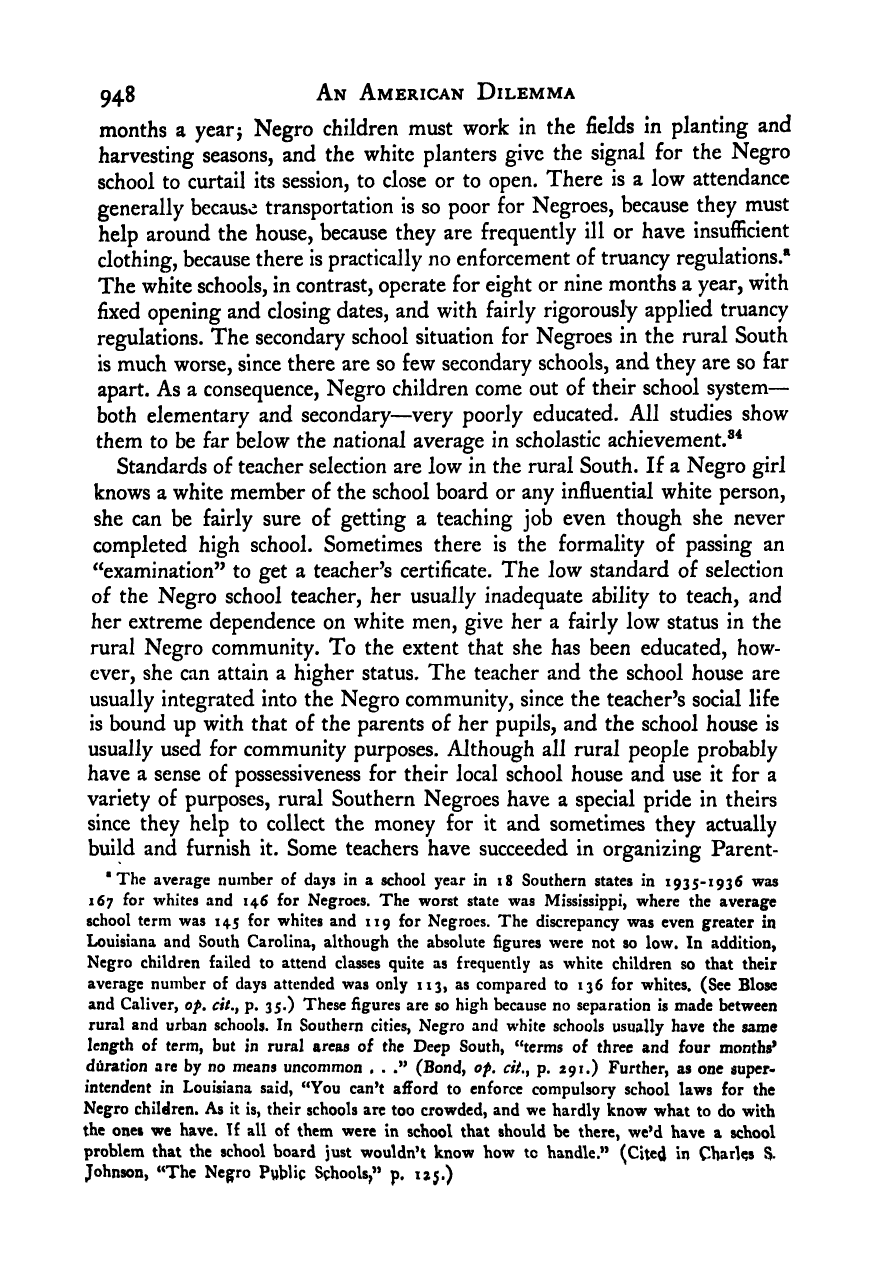Note: Gunnar Myrdal died in 1987, less than 70 years ago. Therefore, this work is protected by copyright, restricting your legal rights to reproduce it. However, you are welcome to view it on screen, as you do now. Read more about copyright.
Full resolution (TIFF) - On this page / på denna sida - X. The Negro Community - 43. Institutions - 4. The Negro School and Negro Education

<< prev. page << föreg. sida << >> nästa sida >> next page >>
Below is the raw OCR text
from the above scanned image.
Do you see an error? Proofread the page now!
Här nedan syns maskintolkade texten från faksimilbilden ovan.
Ser du något fel? Korrekturläs sidan nu!
This page has never been proofread. / Denna sida har aldrig korrekturlästs.
948 An American Dilemma
months a yearj Negro children must work in the fields in planting and
harvesting seasons, and the white planters give the signal for the Negro
school to curtail its session, to close or to open. There is a low attendance
generally because transportation is so poor for Negroes, because they must
help around the house, because they are frequently ill or have insufficient
clothing, because there is practically no enforcement of truancy regulations.®
The white schools, in contrast, operate for eight or nine months a year, with
fixed opening and closing dates, and with fairly rigorously applied truancy
regulations. The secondary school situation for Negroes in the rural South
is much worse, since there are so few secondary schools, and they are so far
apart. As a consequence, Negro children come out of their school system
—
both elementary and secondary—very poorly educated. All studies show
them to be far below the national average in scholastic achievement.^^
Standards of teacher selection are low in the rural South. If a Negro girl
knows a white member of the school board or any influential white person,
she can be fairly sure of getting a teaching job even though she never
completed high school. Sometimes there is the formality of passing an
^^examination” to get a teacher’s certificate. The low standard of selection
of the Negro school teacher, her usually inadequate ability to teach, and
her extreme dependence on white men, give her a fairly low status in the
rural Negro community. To the extent that she has been educated, how-
ever, she can attain a higher status. The teacher and the school house are
usually integrated into the Negro community, since the teacher’s social life
is bound up with that of the parents of her pupils, and the school house is
usually used for community purposes. Although all rural people probably
have a sense of possessiveness for their local school house and use it for a
variety of purposes, rural Southern Negroes have a special pride in theirs
since they help to collect the money for it and sometimes they actually
build and furnish it. Some teachers have succeeded in organizing Parent-
The average number of days in a school year in i8 Southern states in 1935-1936 was
167 for whites and 146 for Negroes. The worst state was Mississippi, where the average
school term was 145 for whites and 119 for Negroes. The discrepancy was even greater in
Louisiana and South Carolina, although the absolute figures were not so low. In addition,
Negro children failed to attend classes quite as frequently as white children so that their
average number of days attended was only 113, as compared to 136 for whites. (See Blose
and Caliver, op, cit,^ p, 35.) These figures are so high because no separation is made between
rural and urban schools. In Southern cities, Negro and white schools usually have the same
length of term, but in rural areas of the Deep South, “terms of three and four months’
ddratjon are by no means uncommon . . .” (Bond, of, cit., p. 291.) Further, as one super*
intendent in Louisiana said, “You can’t afford to enforce compulsory school laws for the
Negro children. As it is, their schools arc too crowded, and we hardly know what to do with
the ones we have. Tf all of them were in school that should be there, we’d have a school
problem that the school board just wouldn’t know how tc handle.” (Cited in Charles S.
Johnson, “The Negro Public Schools,” p. 125.)
<< prev. page << föreg. sida << >> nästa sida >> next page >>